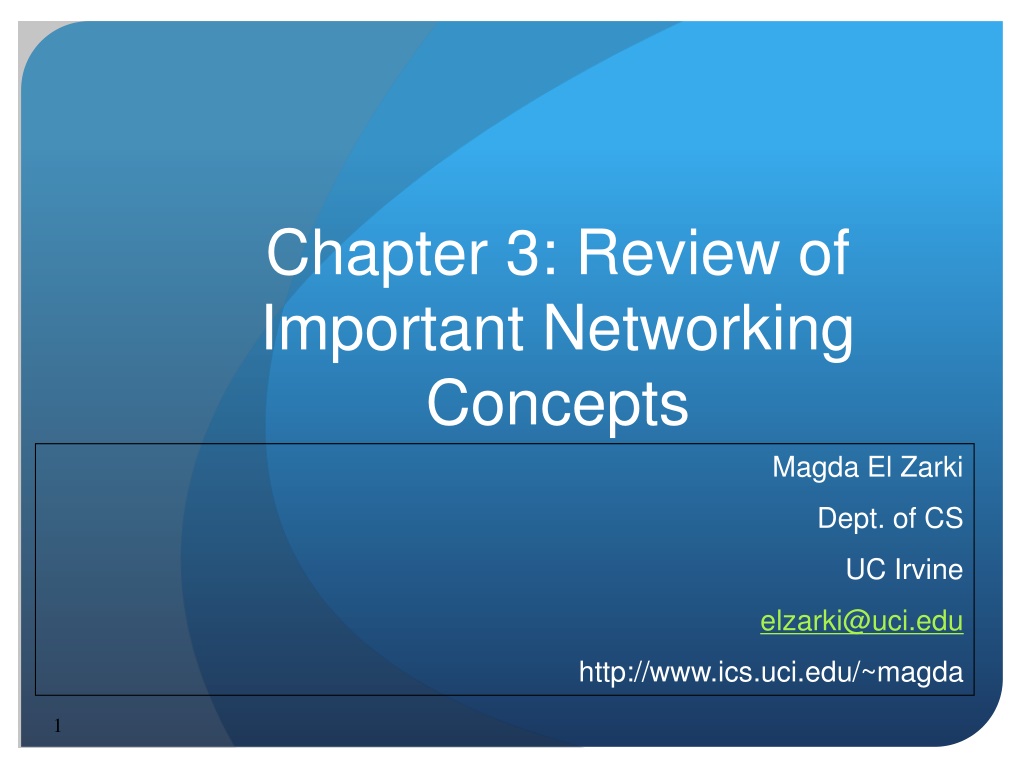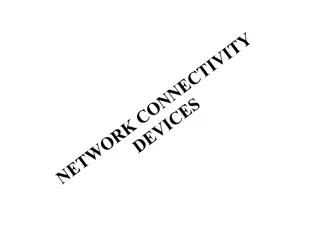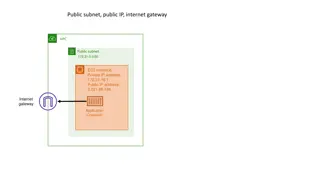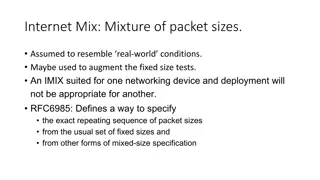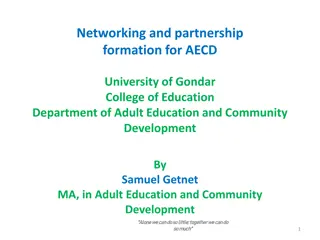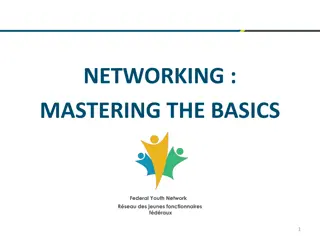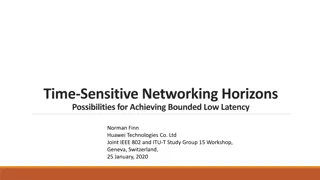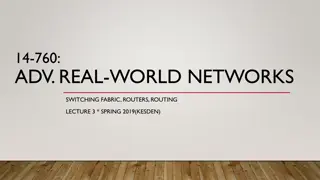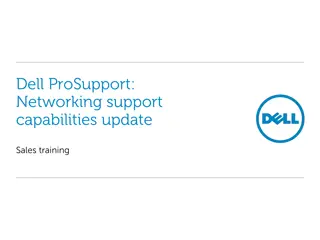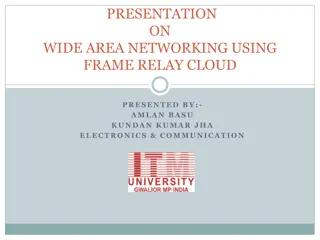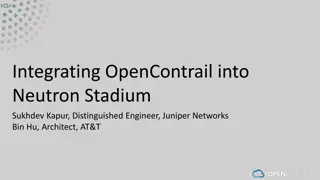Important Networking Concepts Overview
Review essential networking concepts including protocol architecture, protocol layers, encapsulation, network abstractions, communication architecture, and TCP/IP protocol suite. Understand the functions of different layers in networking for reliable data transfer and communication efficiency.
Download Presentation

Please find below an Image/Link to download the presentation.
The content on the website is provided AS IS for your information and personal use only. It may not be sold, licensed, or shared on other websites without obtaining consent from the author. Download presentation by click this link. If you encounter any issues during the download, it is possible that the publisher has removed the file from their server.
E N D
Presentation Transcript
Chapter 3: Review of Important Networking Concepts Magda El Zarki Dept. of CS UC Irvine elzarki@uci.edu http://www.ics.uci.edu/~magda 1
Networking Concepts Protocol Architecture Protocol Layers Encapsulation Network Abstractions 2
Sending a packet from Argon to Neon Therefore, I need to send the packet to my default gateway with address 128.143.137.1 128.143.71.21 is on my local network. Therefore, I can send the packet directly. 128.143.71.21 is not on my local network. DNS: What is the IP address DNS: The IP address of neon.tcpip-lab.edu is 128.143.71.21 128.143.137.1 is 00:e0:f9:23:a8:20 ARP: What is the MAC address of 128.143.137.1? of neon.tcpip-lab.edu ? ARP: The MAC address of ARP: What is the MAC address of 128.143.71.21? ARP: The MAC address of 128.143.137.1 is 00:20:af:03:98:28 frame frame 4
Communications Architecture The complexity of the communication task is reduced by using multiple protocol layers: Each protocol is implemented independently Each protocol is responsible for a specific subtask Protocols are grouped in a hierarchy A structured set of protocols is called a communications architecture or protocol suite 5
TCP/IP Protocol Suite Application User-level programs The TCP/IP protocol suite is the protocol architecture of the Internet Transport Operating system Network The TCP/IP suite has four layers: Application, Transport, Network, and Data Link Layer Data Link End systems (hosts) implement all four layers. Gateways (Routers) only have the bottom two layers. Data Link Sublayer in Local Area Networks Media Access Control (MAC) 6
Functions of the Layers Data Link Layer: Service: Functions: Reliable transfer of frames over a link Media Access Control on a LAN Framing, media access control, error checking Network Layer: Service: host Functions: Transport Layer: Service: Functions: Move packets from source host to destination Routing, addressing Delivery of data between hosts Connection establishment/termination, error control, flow control Application Layer: Service: of HTML Functions: Application specific (delivery of email, retrieval documents, reliable transfer of file) Application specific 7
TCP/IP Suite and OSI Reference Model The TCP/IP protocol stack does not define the lower layers of a complete protocol stack 8
Assignment of Protocols to Layers ping Application Layer HTTP Telnet FTP DNS SNMP application Transport Layer TCP UDP Routing Protocols ICMP RIP Network Layer IP PIM IGMP OSPF DHCP Data Link Layer ARP Ethernet 9 Network Interface
Layers in the Example HTTP HTTP HTTP protocol TCP TCP TCP protocol IP IP IP IP protocol IP protocol Ethernet Ethernet Ethernet Ethernet Ethernet Ethernet argon.tcpip- lab.edu 128.143.137.144 neon.tcpip-lab.edu 128.143.71.21 router71.tcpip- lab.edu 128.143.137.1 00:e0:f9:23:a8:20 router137.tcpip- lab.edu 128.143.71.1 16
Layers in the Example HTTP HTTP Send HTTP Request to neon Establish a connection to 128.143.71.21 at port 80Open TCP connection to 128.143.71.21 port 80 IP datagram is a TCP segment for port 80 TCP TCP Send IP data-gram to 128.143.71.21 Send a datagram (which contains a connection request) to 128.143.71.21 128.143.71.21 IP Send IP datagram to IP IP Frame is an IP datagram Frame is an IP datagram Send the datagram to 128.143.7.21 Send the datagram to 128.143.137.1 Ethernet Ethernet Ethernet Ethernet argon.tcpip- lab.edu 128.143.137.144 neon.tcpip-lab.edu 128.143.71.21 router71.tcpip- lab.edu 128.143.137.1 00:e0:f9:23:a8:20 router137.tcpip- lab.edu 128.143.71.1 Send Ethernet frame to 00:20:af:03:98:28 Send Ethernet frame to 00:e0:f9:23:a8:20 17
Layers and Services Service provided by TCP to HTTP: reliable transmission of data over a logical connection Service provided by IP to TCP: unreliable transmission of IP datagrams across an IP network Service provided by Ethernet to IP: transmission of a frame across an Ethernet segment Other services: DNS: translation between domain names and IP addresses ARP: Translation between IP addresses and MAC addresses 18
Encapsulation and Demultiplexing As data is moving down the protocol stack, each protocol is adding layer-specific control information User data HTTP HTTP Header User data TCP TCP Header HTTP Header User data IP TCP segment IP Header TCP Header HTTP Header User data Ethernet IP datagram Ethernet Header Ethernet Trailer IP Header TCP Header HTTP Header User data Ethernet frame 19
Encapsulation and Demultiplexing in our Example Let us look in detail at the Ethernet frame between Argon and the Router, which contains the TCP connection request to Neon. This is the frame in hexadecimal notation. 00e0 f923 a820 00a0 2471 e444 0800 4500 002c 9d08 4000 8006 8bff 808f 8990 808f 4715 065b 0050 0009 465b 0000 0000 6002 2000 598e 0000 0204 05b4 20
Encapsulation and Demultiplexing 6 bytes destination address 4 bytes source address type CRC Application data Ethernet Header IP Header TCP Header Ethernet Trailer Ethernet frame 21
Encapsulation and Demultiplexing: Ethernet Header 6 bytes 00:e0:f9:23:a8:20 4 bytes 0:a0:24:71:e4:44 0x0800 CRC 22
Encapsulation and Demultiplexing: IP Header 32 bits version (4 bits) header length Total Length (in bytes) (16 bits) DS ECN flags (3 bits) Identification (16 bits) Fragment Offset (13 bits) TTL Time-to-Live (8 bits) Protocol (8 bits) Header Checksum (16 bits) Source IP address (32 bits) Destination IP address (32 bits) 23
Encapsulation and Demultiplexing: IP Header 32 bits 0x4 0x5 0x0 0x0 4410 9d08 0102 00000000000002 12810 0x06 8bff 128.143.137.144 128.143.71.21 24
Encapsulation and Demultiplexing: TCP Header 32 bits Source Port Number Destination Port Number Sequence number (32 bits) Acknowledgement number (32 bits) header length Flags window size 0 TCP checksum option type urgent pointer Option: maximum segment size length Max. segment size Application data TCP Header Ethernet Header IP Header Ethernet Trailer Ethernet frame 25
Encapsulation and Demultiplexing: TCP Header 32 bits 162710 8010 60783510 010 819210 00002 610 0000002 0000102 0x598e 210 410 146010 26
Encapsulation and Demultiplexing: Application data No Application Data in this frame Application data TCP Header Ethernet Header IP Header Ethernet Trailer Ethernet frame 27
Different Views of Networking Different Layers of the protocol stack have a different view of the network. This is HTTP s and TCP s view of the network. Argon Neon 128.143.137.144 128.143.71.21 HTTP server HTTP server HTTP client TCP client TCP server TCP server IP Network 28
Network View of IP Protocol 128.143.137.144 128.143.71.21 128.143.137.1 128.143.71.1 Router 128.143.71.0/24 Network 128.143.137.0/24 Network 29
Network View of Ethernet Ethernet s view of the network Argon (128.143.137.144) Router137 (128.143.137.1) Ethernet Network 30
IP Addresses Structure of an IP address Subnetting CIDR
IP Addresses 32 bits version (4 bits) header length Type of Service/TOS (8 bits) Total Length (in bytes) (16 bits) flags (3 bits) Identification (16 bits) Fragment Offset (13 bits) TTL Time-to-Live (8 bits) Protocol (8 bits) Header Checksum (16 bits) Source IP address (32 bits) Destination IP address (32 bits)
IP Addresses 32 bits 0x4 0x5 0x00 4410 9d08 0102 00000000000002 12810 0x06 8bff 128.143.137.144 128.143.71.21
What is an IP Address? An IP address is a unique global address for a network interface An IP address: is a 32 bit long identifier encodes a network number (network prefix) and a host number
Dotted Decimal Notation IP addresses are written in a so-called dotted decimal notation Each byte is identified by a decimal number in the range [0..255]: 10001111 10001001 10010000 10000000 1st Byte 2nd Byte 3rd Byte 4th Byte = 128 = 143 = 137 = 144 128.143.137.144
Network prefix and Host number The network prefix identifies a network and the host number identifies a specific host (actually, interface on the network). network prefix host number How do we know how long the network prefix is? The network prefix is implicitly defined (class-based addressing) The network prefix is indicated by a netmask.
Example Example: ellington.cs.virginia.edu 128.143 137.144 Network id is: 128.143.0.0 Host number is: 137.144 Network mask is: 255.255.0.0 or ffff0000 Prefix notation: 128.143.137.144/16 Network prefix is 16 bits long
Subnetting Problem: Organizations have multiple networks which are independently managed Solution 1: Allocate one or more addresses for each network Difficult to manage -> From the outside of the organization - each network must be addressable. University Network Engineering School Medical School Library Solution 2: Add another level of hierarchy to the IP addressing structure Subnetting
Basic Idea of Subnetting Split the host number portion of an IP address into a subnet number and a (smaller) host number. Result is a 3-layer hierarchy network prefix host number subnet number host number network prefix extended network prefix Then: Subnets can be freely assigned within the organization Internally, subnets are treated as separate networks Subnet structure is not visible outside the organization
Typical Addressing Plan for an Organization that uses subnetting Each layer-2 network (Ethernet segment, FDDI segment) is allocated a subnet address when connected to a router. 128.143.71.0 / 24 R 128.143.0.0/16 128.143.16.0 / 24 Gateway 128.143.8.0 / 24 128.143.7.0 / 24 Router R 128.143.17.0 / 24 128.143.22.0 / 24 R 128.143.136.0 / 24
Advantages of Subnetting With subnetting, IP addresses use a 3-layer hierarchy: Network Subnet Host Improves efficiency of IP addresses by not consuming an entire address space for each physical network. Reduces router complexity. Since external routers do not know about subnetting, the complexity of routing tables at external routers is reduced. Note: Length of the subnet mask need not be identical at all subnetworks.
CIDR - Classless Interdomain Routing Goals: Restructure IP address assignments to increase efficiency Hierarchical routing aggregation to minimize route table entries Key Concept: The length of the network id (prefix) in the IP addresses is kept arbitrary Consequence: Routers advertise the IP address and the length of the prefix
CIDR Example CIDR notation of a network address: 192.0.2.0/18 "18" says that the first 18 bits are the network part of the address (and 14 bits are available for specific host addresses) The network part is called the prefix Assume that a site requires a network address with 1000 addresses With CIDR, the network is assigned a continuous block of 1024 addresses with a 22-bit long prefix
CIDR: Prefix Size vs. Network Size CIDR Block Prefix # of Host Addresses /27 32 hosts /26 64 hosts /25 128 hosts /24 256 hosts /23 512 hosts /22 1,024 hosts /21 2,048 hosts /20 4,096 hosts /19 8,192 hosts /18 16,384 hosts /17 32,768 hosts /16 65,536 hosts /15 131,072 hosts /14 262,144 hosts /13 524,288 hosts
CIDR and Address assignments Backbone ISPs obtain large block of IP addresses space and then reallocate portions of their address blocks to their customers. Example: Assume that an ISP owns the address block 206.0.64.0/18, which represents 16,384 (232-18=214) IP addresses Suppose a client requires 800 host addresses With CIDR: Assign a /22 block (512=29<800<1024=210 -> 32- 10=22), i.e., 206.0.68.0/22 gives a block of 1,024 (210) IP addresses.
CIDR and Routing Information Company X : 206.0.68.0/22 ISP X owns: 206.0.64.0/18 204.188.0.0/15 209.88.232.0/21 Internet Backbone ISP y : 209.88.237.0/24 Organization z1 : Organization z2 : 209.88.237.192/26 209.88.237.0/26
CIDR and Routing Information anything about Company X, ISP Y, or Organizations z1, z2. Backbone routers do not know Company X : 206.0.68.0/22 ISP X owns: ISP y sends everything which matches the prefix: 209.88.237.192/26 to Organizations z1 209.88.237.0/26 to Organizations z2 ISP X does not know about Organizations z1, z2. 206.0.64.0/18 204.188.0.0/15 209.88.232.0/21 Internet Backbone matches the prefix: 206.0.68.0/22 to Company X, 209.88.237.0/24 to ISP y ISP X sends everything which ISP y : 209.88.237.0/24 Backbone sends everything which matches the prefixes 206.0.64.0/18, 204.188.0.0/15, 209.88.232.0/21 to ISP X. Organization z1 : Organization z2 : 209.88.237.192/26 209.88.237.0/26
Example The IP Address: 207.2.88.170 207 2 88 170 10101010 11001111 00000010 01011000 Belongs to: City of Charlottesville, VA: 207.2.88.0 - 207.2.92.255 00000000 11001111 00000010 01011000 Belongs to: Cable & Wireless USA 207.0.0.0 - 207.3.255.255 00000000 11001111 00000000 00000000
CIDR and Routing Aggregation of routing table entries: 128.143.0.0/16 and 128.142.0.0/16 are represented as 128.142.0.0/15 Longest prefix match: Routing table lookup finds the routing entry that matches the longest prefix Prefix Interface 128.0.0.0/4 128.128.0.0/9 interface #5 interface #2 What is the outgoing interface for 128.143.128.0/17 interface #1 128.143.137.0 ? Routing table
